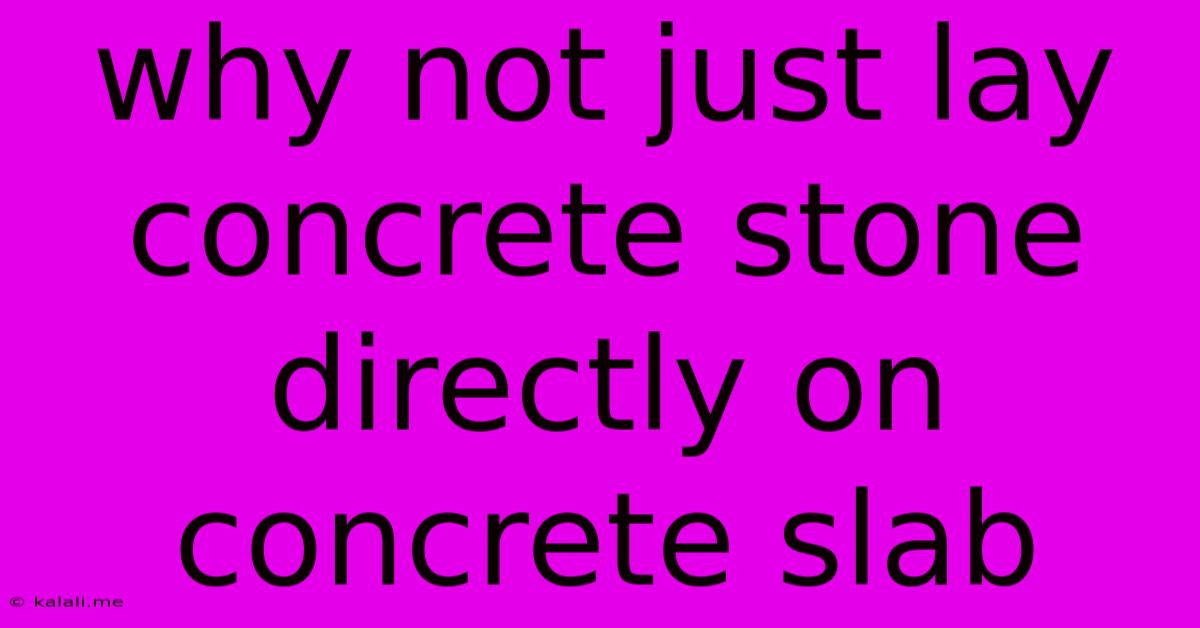Why Not Just Lay Concrete Stone Directly On Concrete Slab
Kalali
Jun 04, 2025 · 3 min read

Table of Contents
Why Not Just Lay Concrete Pavers Directly on a Concrete Slab? A Comprehensive Guide
Many homeowners considering a patio or walkway renovation wonder: why bother with a base layer? Why not simply lay concrete pavers directly onto an existing concrete slab? While it seems like a quicker, cheaper solution, skipping the proper base can lead to significant problems down the line. This article will explain why a proper base is crucial for long-lasting, aesthetically pleasing paver installations. The short answer is that it's all about stability, drainage, and longevity.
Problems with Direct Installation
Laying concrete pavers directly onto a concrete slab invites several issues:
-
Cracking and Shifting: Concrete slabs, even seemingly stable ones, can shift, crack, or settle over time due to temperature changes, frost heaves (in colder climates), or underlying soil movement. This movement will inevitably transfer to the pavers, causing cracking, uneven settling, and an unsightly finished product. A properly prepared base acts as a buffer, absorbing these movements and preventing damage to the pavers.
-
Poor Drainage: Concrete slabs can be surprisingly impermeable. Water trapped beneath the pavers will have nowhere to go, leading to frost damage (in cold climates), increased risk of mold and mildew growth, and the potential for pavers to lift or become unstable. A base layer with appropriate drainage solutions allows for proper water runoff.
-
Uneven Surface: Even seemingly level concrete slabs often have minor imperfections. These imperfections will be directly transferred to the pavers, resulting in an uneven surface that is both unattractive and potentially hazardous. A base layer provides a level and stable foundation to ensure the pavers are installed at consistent height.
-
Reduced Lifespan: The combination of these factors drastically shortens the lifespan of your paver installation. Repairing or replacing pavers damaged by poor installation is far more costly and time-consuming than doing it right the first time.
The Importance of a Proper Base
A well-prepared base is the key to a successful paver installation. This typically involves several layers:
-
Weed Barrier Fabric: This helps prevent weeds from growing up through the pavers and damaging the base.
-
Compacted Gravel Base: A layer of compacted gravel provides excellent drainage and distributes weight evenly across the base, preventing settling. The gravel should be properly compacted to provide a stable foundation.
-
Sand Bedding: A layer of sand provides a level and even surface for the pavers, allowing for adjustments and preventing settling after installation.
Alternative Solutions for Existing Concrete
If you're determined to work with an existing concrete slab, consider these alternatives to direct installation:
-
Concrete Slab Overlaying: Adding a new layer of concrete over the existing slab provides a stronger, more level base.
-
Removal and Replacement: If the existing slab is severely damaged or cracked, it is generally more cost-effective in the long run to remove and replace it with a new, level slab.
Conclusion
While the immediate appeal of skipping the base layer and laying pavers directly onto a concrete slab is understandable, it's a false economy. Investing the time and effort into proper base preparation guarantees a longer-lasting, more aesthetically pleasing, and safer paver installation. In the long run, this proactive approach will save you money, time, and frustration. Choosing the correct base material and using proper techniques will result in a beautiful patio or walkway you can enjoy for years to come.
Latest Posts
Latest Posts
-
How To Make A Rooster Stop Crowing
Jun 06, 2025
-
Cold Tire Pressure Vs Hot Tire Pressure
Jun 06, 2025
-
Best Glue To Bond Plastic To Metal
Jun 06, 2025
-
Do I Have To Sand My Deck Before Staining
Jun 06, 2025
-
Does A Reverse Osmosis System Remove Fluoride
Jun 06, 2025
Related Post
Thank you for visiting our website which covers about Why Not Just Lay Concrete Stone Directly On Concrete Slab . We hope the information provided has been useful to you. Feel free to contact us if you have any questions or need further assistance. See you next time and don't miss to bookmark.